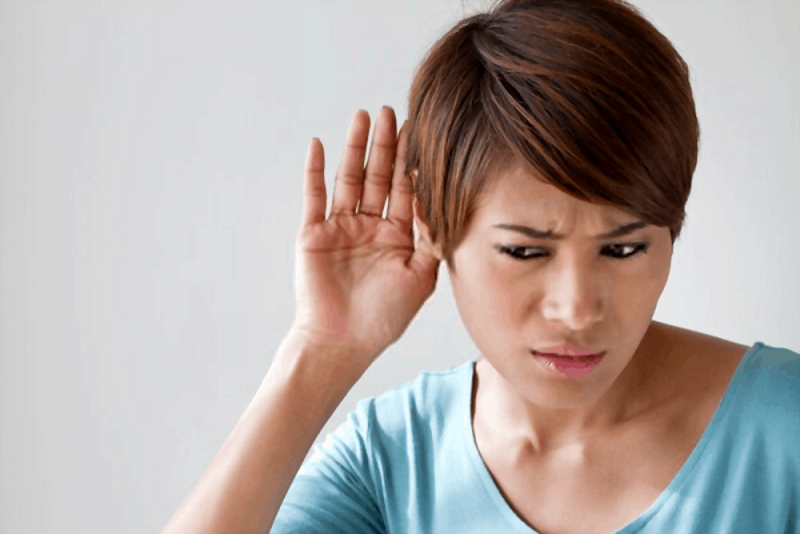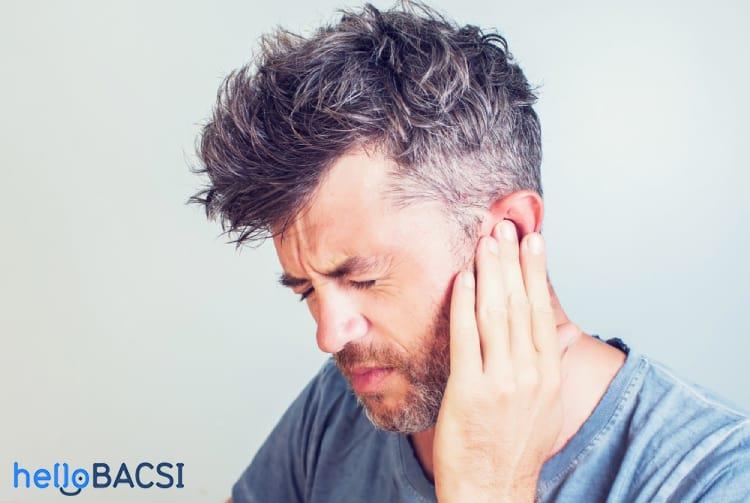Ear pain when swallowing: What causes it?

Ear pain when swallowing can have many causes. Therefore, you should not be subjective but need to visit the hospital for proper diagnosis and treatment.
Let's find out the causes of ear pain when swallowing and how to treat it in the following article.
Having an earache due to an ear infection
Ear infections are a common cause of ear pain when swallowing. Most ear infections, which appear in the middle ear, are caused by bacteria or viruses. The disease often causes swelling, fluid buildup, and ear irritation, causing discomfort and pain.
Ear infections are common in both children and adults. Ear infections in adults can have different symptoms than ear infections in children.
Middle ear infection
Middle ear infection is also called acute otitis media. This is damage and inflammation caused by bacteria in the space behind the eardrum. The middle ear contains small bones that allow you to hear sounds. It is connected to the pharynx by a small tube called the eustachian tube.
Most ear infections come from other health problems, such as colds, flu, sinusitis, or allergies. The eustachian tube sucks fluid from the middle ear. In some cases, this tube can become blocked causing fluid to build up and cause an infection.
The eustachian tube is also responsible for maintaining pressure in the middle ear. When you swallow, yawn, or sneeze, the eustachian tube opens to release pressure. If your ear becomes infected, it will cause pain.

Signs of an ear infection in young children may include:
- Ear pain when lying down
- Ear twitching or pulling on the ear (occurs with other symptoms)
- Crying
- Irritability, irritability
- Fever over 38°C
- Doesn't taste good
- Drainage from the ear
- Overbalance
- Difficulty sleeping
- Headache
Middle ear infections in adults can have symptoms such as:
- Mild fever
- Ear hurt
- Drainage from the ear
- Poor hearing
Many middle ear infections clear up on their own within a week. Oral antibiotics can help ease an infection, especially in young children.
Outer ear infection
An outer ear infection is usually caused by water that collects in your ear canal after swimming or bathing. This creates a moist environment that is ideal for bacteria and fungi to thrive.

However, there are also cases of external ear infections that are not caused by standing water in the ear. Germs can get into the ear canal through a foreign object, such as your finger. In addition to us, skin problems like eczema can also be the cause of an outer ear infection.
The pain from an outer ear infection is often worse when the ear is pulled or when you chew or swallow food. The pain may spread to the entire face around the infected ear.
Other symptoms of an outer ear infection include:
- Red and swollen ears
- Itching inside the ear
- Ear discharge has an unpleasant odor
- The feeling of fullness in the ear
- Hard to hear
External ear infections can usually be cured with ear drops in 7-10 days. In addition, over-the-counter pain relievers can provide effective pain relief during recovery.
Suffering from ear pain due to infection of the nose and throat
Ear infections are the most common cause of ear pain. In addition, ear pain can also stem from an infection of the nose or throat.
In children, ear pain caused by infections of the nose and throat can cause complications. At this time, the child's immune system is affected. Behind the nasal passages, near the eustachian tubes, are small masses of tissue called adenoids. These adenoids play an important role in the immune system of children.
Adenoids react to germs that enter through a child's mouth and nose. Sometimes, the adenoids get too large, blocking the eustachian tube, leading to middle ear infections.
Tonsillitis
The tonsils are lymphatic tissue located at the back of the throat. Tonsillitis is an infection of the tonsils, causing pain and swelling.

The main symptom of tonsillitis is a sore throat. Other symptoms may include:
- Difficulty swallowing
- Lymph nodes in the neck become sensitive
- Swelling, redness, or inflammation of the tonsils
- Appearance of white patches at the back of the throat
- Fever
- Headache
- Stomachache
- Rash
- Halitosis
- Hoarseness
The most common cause of tonsillitis is a bacterial infection. Tonsillitis is usually caused by the bacteria that causes strep throat (group A Streptococcus). Using antibiotics is the most effective and commonly used method of tonsillitis treatment.
Abscess around the tonsils
A peritonsillar abscess is a collection of pus around one of your tonsils. This disease is often a complication of untreated tonsillitis. The pain of a peritonsillar abscess is usually quite severe and markedly worse than a common sore throat.
Abscesses usually occur in only one tonsil. As a result, you will feel a lot of pain on one side.

Abscesses around the tonsils usually cause pain in the ear on the affected side. When you swallow, you may experience a very severe earache. In addition, you may also experience pain when opening your mouth.
In most cases, minor surgery is needed to completely treat the abscess. The doctor will make an incision or use a fine needle to drain the pus. They may also prescribe antibiotics to treat the underlying tonsillitis and prevent the abscess from recurring.
Other causes of ear pain when swallowing
Eagle syndrome
Hội chứng Eagle là một rối loạn hiếm gặp, gây ra cơn đau tái phát ở phía sau cổ họng và mặt. Cơn đau họng thường âm ỉ, dai dẳng và có thể lan ra tai. Cơn đau thường trở nên tồi tệ hơn khi bạn di chuyển đầu.
Theo Healthline, các triệu chứng khác của hội chứng Eagle có thể bao gồm:
- Nuốt khó
- Cảm giác mắc kẹt thứ gì đó trong cổ họng
- Ù tai
- Đau cổ
- Đau mặt

Các vấn đề về dây chằng và xương nhỏ của cổ hoặc hộp sọ là nguyên nhân dẫn đến hội chứng Eagle. Trong đa số trường hợp, bệnh có thể được khắc phục bằng phương pháp phẫu thuật.
Đau dây thần kinh glossopharyngeal (GPN)
glossopharyngeal neuralgia (GPN) is a rare condition. It involves a nerve of the head and neck, called the glossopharyngeal nerve. GPNs typically cause brief, intense attacks of pain that are often triggered when you swallow, yawn, talk, cough, or chew. The pain is usually centered around one ear, but you may also have pain in your tongue, back of your throat, face, or under your jaw.
Episodes of GPN usually last about two minutes, followed by a dull ache. To treat GPN, your doctor may prescribe neuropathic pain medications such as pregabalin and gabapentin. If medication doesn't work, you may need surgery to correct the condition.
Temporomandibular joint dysfunction
The temporomandibular joint is where the jawbone connects to the skull. Temporomandibular joint dysfunction affects your ability to open and close your mouth.
Since you use this joint quite often, a temporomandibular joint disorder will make your pain worse.
Other symptoms of temporomandibular joint disorders include:
- Difficulty opening mouth
- Soreness and discomfort in the jaw
- Jaw locked
- There is a strange sound when you open your mouth
- Chronic headaches and neck pain
- Tinnitus
Temporomandibular joint disorders can be caused by trauma, teeth grinding, and excessive gum chewing. Treatment for ear pain caused by a temporomandibular joint disorder usually includes lifestyle changes, rest, and the use of nonsteroidal anti-inflammatory drugs, such as ibuprofen (Advil, Motrin).
